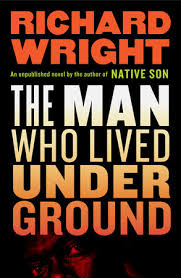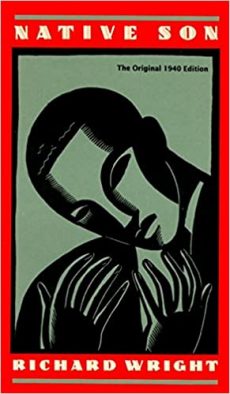This content is being reviewed in light of recent changes to federal guidance.
Book Review: Richard Wright’s The Man Who Lived Underground (2021)
Categories: HBW, Guest Blogger
Last fall, during HBW’s 2020 Black Literary Suite “Black Writing in Reel Time,” we received the news from Julia Wright, regarding the forthcoming publication of unpublished novel by her father Richard Wright (1908-1960). A portion of that novel had first appeared in 1942, but most readers first learned of it in Wright’s short story collection, “Eight Men” (1960). We are pleased to conclude Black History Month 2021 with a review of The Man Who Lived Underground by HBW alum, Morgan McComb. The official release date for The Library of America edition is April 4, 2021.

The Man Who Lived Underground (2021)
A marked departure from the literary naturalism of Wright’s Native Son, TMWLU is instead an existential allegory exploring topics as seemingly disparate as religion, racism, capitalism, war, police surveillance and brutality. The only simple thing about Wright’s novel is its title. The protagonist, Fred Daniels, does literally live in the sewers after he escapes from being arrested and brutally beaten by the police for a murder he did not commit. Wright’s prose, however, layered with inverted images of darkness and light and saturated in language that deliberately confuses the senses, demands more of his narrative and us as readers than an overly-simplified understanding of the novel as a literary meditation on Daniels’s plight as a Black man escaping a violently racist society (though it is certainly that, too). While racism and racial violence at the hands of the police is undoubtedly the impetus for Daniels’s flight, Daniels’ time spent underground thrusts him into encounters that expand the thematic scope of the novel, ultimately creating what his grandson Malcolm Wright describes in the text’s afterword as an inversion of Plato’s allegory of the cave.

PC: NY Times

Wright’s novel is a valuable addition to an understanding of his overall artistic legacy for its distinctive and dynamic allegorical rendering of Black thought alone; but its timely commentary on institutionalized racism and the psychological toll of white supremacy makes its narrative even more powerful and urgent to us in our contemporary moment.
In addition to the unpublished full text of the novel, the Library of America’s edition also includes a previously unpublished essay by Wright, “Memories of My Grandmother,” in which he cites his grandmother’s intense and restrictive religious beliefs as a Seventh Day Adventist as a foremost influence in the thematic and artistic impetuses that shaped the novel alongside surrealist art, jazz and blues music, and psychoanalytical theory. An extended meditation on both the craft and personal philosophy that led to TMWLU’s creation, Wright begins the essay with an emphatic statement that TMWLU is his favorite piece he has ever written, one in which he felt he had complete freedom of expression and a piece where he pushed himself to move beyond a singular thematic focus on race. Despite the fact that Wright’s novel is layered with images and motifs, Wright is pointed in his assertion that none of these images and motifs are meaningful in and of themselves; for Wright, the concern is the relation of all these images, and he cautions the reader and critic not to over-invest in interpretations focusing on a single image or moment.
Instead, in likening the novel to the free play of jazz, the juxtaposed lyrics of blues, and his grandmother’s fanatical beliefs grounded in her religion, Wright insists the novel must be understood in its complex layering of all of these things, a layering that may not appear as narratively logical or interpretively sound. This complex construction is found in Wright’s narrative style as well: his prose is layered with contradictory imagery, and descriptions of Daniels’s experiences underground are defined by language that focuses on the instability of sensory experience—the light of diamonds laughs, fear feels wet on Daniels’s skin, guilt is described as compacted sediment in the mind. The novel’s incongruous layering, according to Wright, is emblematic of a distinctive kind of Black thought, one that brings seemingly disparate and unrelated parts into a complex interplay of meaning. This mosaic rendering of Black thought is perhaps what kept TMWLU from being published during a time when white publishers were instead looking for an uncomplicated narrative about Black domestic workers that did not discomfit their own whiteness it is (a publishing impetus that today: one only need look at the literary and cultural “success” of Kathryn Stockett’s The Help (2009), a novel written by a white woman and focused on Black domestic workers in the South, to recognize this continued reduction of Black identities in the American publishing industry). Wright’s novel is a valuable addition to an understanding of his overall artistic legacy for its distinctive and dynamic allegorical rendering of Black thought alone; but its timely commentary on institutionalized racism and the psychological toll of white supremacy makes the narrative even more powerful and urgent to us in our contemporary moment.
[1] This—an excision of his wife from the narrative and a lack of attention on aspects of gender—is perhaps the only critique I can offer of the novel. Critical grapplings with Wright’s writing (or lack thereof) on the specific issues faced by Black women implicated in Wright’s narratives are numerous, and it is an issue that Wright addresses directly in reference to TMWLU in his accompanying essay, “Memories of My Grandmother.”
More on Richard Wright
Richard Wright’s Legacy: Remembering George Floyd – Part 1
Richard Wright’s legacy and remembering George Floyd – Part 2
Richard Wright’s legacy and remembering George Floyd – Part 3
Richard Wright’s ‘Black Boy’ Celebrates 75th Anniversary
Turner Classic Movies Native Son (1951)

Morgan McComb is an English PhD student at the University of Mississippi whose research focuses on understudied Black women poets and Black Feminist Theory. She earned her masters from the University of Kansas where her thesis focused on the work of Naomi Long Madgett. She is currently working on a dissertation that focuses on the legacy of the work of Phillis Wheatley in Black women’s poetry and print culture. McComb has also published reviews in the College Language Association Journal.